
Confías en hojas de afeitar circulares Para mantener sus máquinas industriales funcionando sin problemas. Cuando las cuchillas duran más, se reducen los tiempos de inactividad, se reducen los costos y se logran cortes más precisos en todo momento. Un mantenimiento adecuado puede prolongar la vida útil de las cuchillas de dos a tres veces. Algunas cuchillas cuentan con tecnología de autoafilado o recubrimientos especiales, y las cuchillas personalizadas pueden durar hasta 80% más gracias a estos avances. La siguiente tabla muestra cómo los diferentes tipos de cuchillas y métodos de cuidado afectan su vida útil:
| Tipo de cuchilla | esperanza de vida promedio | Factores clave que afectan la esperanza de vida | Técnicas de prolongación de la vida útil e impacto |
|---|---|---|---|
| Cuchillas peletizadoras | 6–12 meses | Corte de alta velocidad, resistencia al desgaste. | Cuchillas autoafilables: hasta 80% más vida útil |
| Cuchillas de granulador | 12–18 meses | Contaminación, abrasividad | Recubrimientos de carburo de tungsteno: triple resistencia al desgaste |
| Cuchillas de corte rotativas | 9–15 meses | Velocidad de corte, espesor de película | Recubrimientos DLC/teflón: hasta 40% más vida útil |
| Cuchillas trituradoras | 12–24 meses | Esfuerzo de impacto, dureza de la materia prima | Mantenimiento de IA: hasta 40% más vida útil |
Para obtener los mejores resultados, póngase en contacto con Nanjing Metal para explorar su gama de hojas de afeitar circulares y cuchilla personalizada Soluciones diseñadas para mejorar el rendimiento y la durabilidad de su maquinaria.
También se puede observar que la nueva tecnología de cuchillas ayuda a que las máquinas funcionen mejor y se detengan con menos frecuencia:
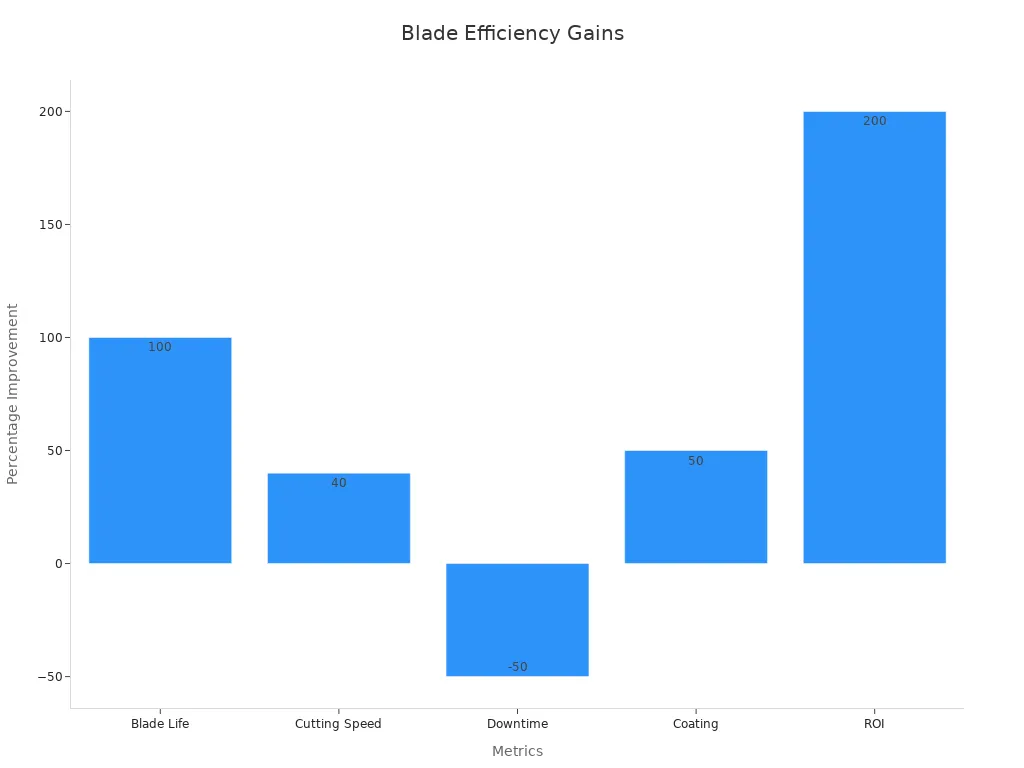
Puntos clave
- Limpie las hojas de afeitar circulares después de cada uso. Esto elimina la suciedad y previene la oxidación.
- Mantenga las aspas en lugares secos y bien ventilados. Asegúrese de que la humedad se mantenga por debajo de 50%. Esto ayuda a prevenir la corrosión.
- Aplique aceite para cuchillas antes de guardarlas por un tiempo prolongado. El aceite protege contra la humedad y el óxido.
- Lubrique las piezas de la máquina con frecuencia. Esto reduce la fricción y prolonga la vida útil de las cuchillas y las máquinas.
- Afile las hojas de afeitar de doble filo con frecuencia. Use una correa de cuero o una piedra de afilar. Esto mantiene los cortes suaves y protege la máquina.
- Manipule las cuchillas con cuidado. Sujételas por los filos, use guantes y utilice soportes adecuados. Esto evita daños.
- Gire las cuchillas con frecuencia. Esto garantiza que se desgasten uniformemente y duren más.
- Cambie las cuchillas inmediatamente si se desafilan, se astillan, se oxidan o cortan mal. Esto mantiene las máquinas seguras y en buen funcionamiento.
Longevidad de las hojas de afeitar circulares
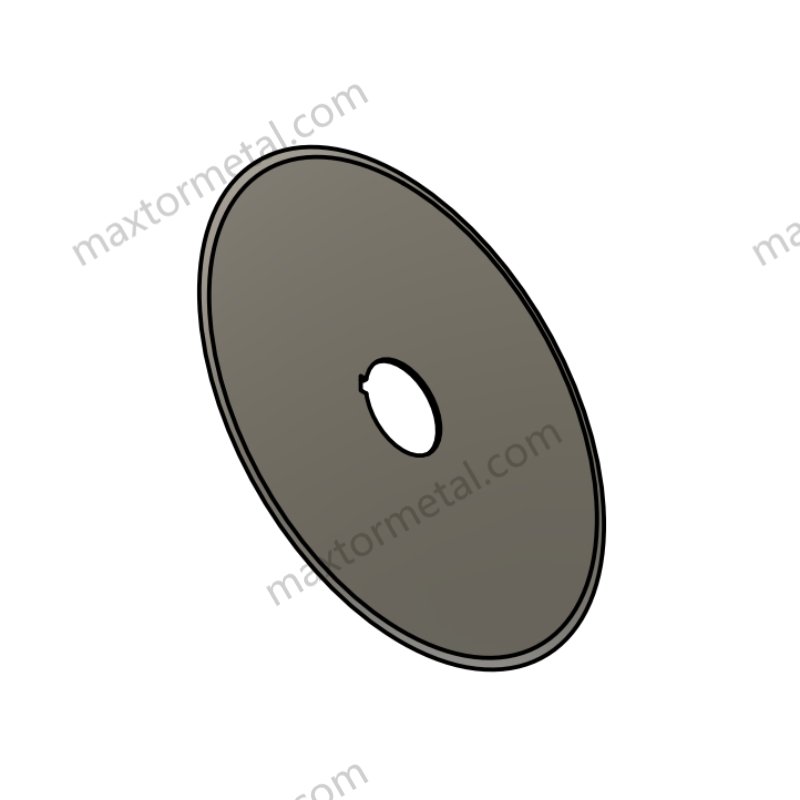
Por qué es importante la longevidad
Necesitas cuchillas de afeitar para que las máquinas funcionen correctamente. Si las cuchillas duran más, aprovechas más cada una. Esto significa que no tienes que comprar cuchillas nuevas con tanta frecuencia. Ahorras dinero y tus máquinas siguen funcionando sin parar. Cuidando de tu... hojas de afeitar circulares Ayuda a que duren mucho más. Pasarás menos tiempo cambiando cuchillas y más cortando.
El cuidado de sus cuchillas es muy importante. Si las limpia con frecuencia y detecta daños a tiempo, evitará problemas antes de que empeoren. Estudio de caso de Milwaukee BroachLos trabajadores usaban cuchillas y rectificadoras de buena calidad. Podían cortar materiales con rapidez y precisión. Esto les ayudaba a fabricar más productos y a confiar en sus máquinas. No perdían tiempo ni dinero reparando cuchillas rotas.
El caso práctico de Saint Gobain demostró lo mismo. Sus rectificadoras trabajaron con materiales duros y terminaron los trabajos más rápido. Esto demuestra que el cuidado de las cuchillas y las máquinas ofrece mejores resultados y ahorra tiempo.
Consejo: Limpie las cuchillas, compruebe que estén afiladas y que estén bien alineadas. Esto prolongará su vida útil y evitará problemas inesperados.
Costo y eficiencia
Al cuidar sus cuchillas, ahorra dinero. Los establecimientos que realizan mantenimiento regular gastan hasta $301 TP4T menos en cuchillas nuevas cada año. También tienen aproximadamente $251 TP4T menos de tiempo de inactividad que los establecimientos que no realizan el mantenimiento. Unas cuchillas en buen estado pueden cortar hasta $201 TP4T más de material antes de tener que cambiarlas.
Aquí hay algunas formas sencillas de ahorrar dinero y trabajar mejor:
- Limpie las cuchillas con frecuencia para evitar la suciedad y el óxido.
- Busque rayones, astillas o cambios de color.
- Asegúrese de que las cuchillas encajen bien para que se desgasten de manera uniforme.
- Pruebe cada semana que las cuchillas estén afiladas y alineadas.
- Compruebe el grosor y el equilibrio de la cuchilla una vez al mes.
Estos pasos le ayudan a usar sus cuchillas por más tiempo. Sus máquinas siguen funcionando bien y usted no gasta dinero en cuchillas nuevas demasiado pronto. Al prolongar la vida útil de las cuchillas, ayuda a su equipo, ahorra dinero y alcanza sus objetivos.
Limpieza de hojas de afeitar circulares
Mantener limpias las hojas de afeitar circulares ayuda a que duren más y funcionen mejor. La suciedad, el polvo y los residuos pueden acumularse en ellas. Si no las limpia, pueden desafilarse u oxidarse. Siga estos pasos para asegurarse de que sus hojas se mantengan en perfecto estado.
Pasos de limpieza adecuados
Preparación
Para empezar, apague la máquina y asegúrese de que la cuchilla esté fría. Use guantes de seguridad para protegerse las manos. Prepare sus herramientas de limpieza, como un cepillo suave, un paño sin pelusa y una solución limpiadora suave. Coloque la cuchilla sobre una superficie estable.
Enjuague de atrás hacia adelante
Sujete la cuchilla con la parte posterior orientada hacia la fuente de agua. Enjuáguela de atrás hacia adelante. Este método aleja los residuos del filo y evita que la suciedad se acumule en los huecos de la cuchilla. Use un chorro de agua suave para evitar daños.
Eliminación de escombros y contaminantes
Use un cepillo suave para eliminar cualquier residuo adherido. Preste mucha atención a los espacios entre los filos de las cuchillas. Si observa residuos persistentes, sumerja la cuchilla en un limpiador alcalino suave durante unas horas. Este paso ayuda a aflojar la suciedad difícil. Después de remojarla, vuelva a cepillarla para eliminar todos los residuos. Un usuario que limpió una afeitadora eléctrica de varias cuchillas descubrió que remojar y cepillar eliminaba todos los residuos, restauraba su rendimiento y dejaba la cuchilla como nueva. Esto demuestra que una limpieza cuidadosa puede prolongar la vida útil de las cuchillas y hacer que funcionen mejor.
Secar bien las cuchillas
Seque la cuchilla inmediatamente después de limpiarla. Use un paño sin pelusa para secar el agua. También puede usar aire comprimido para eliminar la humedad de las zonas difíciles de alcanzar. Asegúrese de que la cuchilla esté completamente seca antes de volver a colocarla en la máquina. El agua que quede en la cuchilla puede causar oxidación y acortar su vida útil.
Consejo: Seque siempre las cuchillas por completo. Incluso una pequeña cantidad de agua puede provocar óxido o corrosión.
Cómo evitar la acumulación de residuos
Programa de limpieza regular
Establezca un programa de limpieza regular para sus cuchillas. Límpielas después de cada uso o al final de cada turno. Este hábito evita que se acumule suciedad y residuos. Sus cuchillas se mantendrán afiladas y listas para el siguiente trabajo.
Cómo elegir los agentes de limpieza adecuados
Elija una solución de limpieza adecuada para el material de su cuchilla. Use limpiadores alcalinos suaves para la mayoría de las cuchillas industriales. Evite los productos químicos agresivos que puedan dañar la superficie de la cuchilla. Pruebe primero los limpiadores nuevos en una zona pequeña.
Inspección de residuos después de la limpieza
Después de limpiar la cuchilla, revise si hay restos de suciedad o manchas. Observe detenidamente los espacios y los bordes. Si ve algún residuo, repita los pasos de limpieza. Las cuchillas limpias cortan mejor y duran más.
Nota: Las cuchillas limpias ayudan a que sus máquinas funcionen sin problemas y reducen la necesidad de un reemplazo prematuro.
Almacenamiento para la longevidad
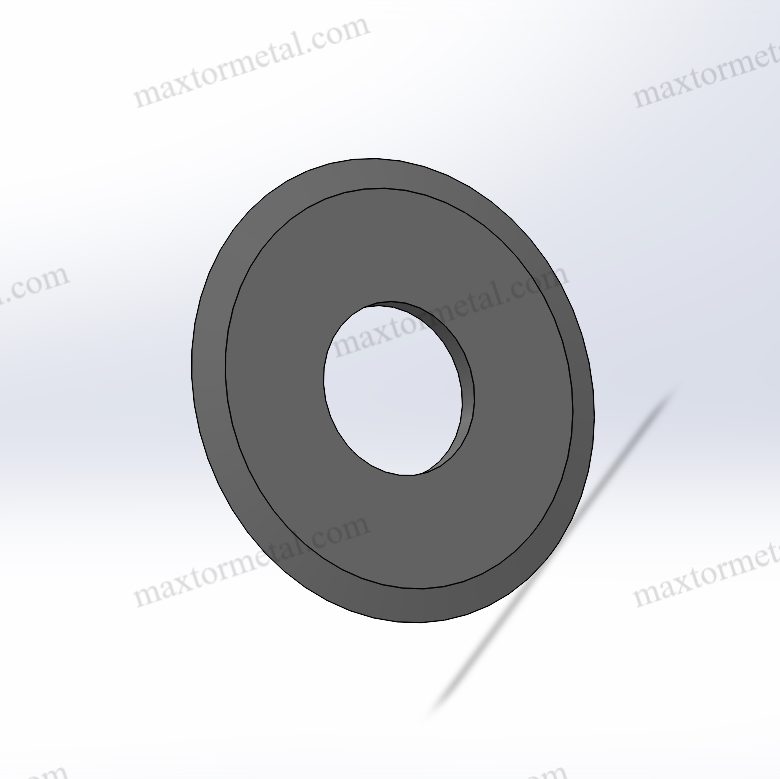
Un almacenamiento adecuado ayuda a que sus hojas de afeitar duren más y funcionen mejor. Si las almacena correctamente, las protege de la oxidación, los daños y el desgaste. Además, mantiene sus máquinas funcionando sin problemas. Siga estas prácticas recomendadas para aprovecharlas al máximo. hojas de afeitar circulares.
Ambientes secos
Importancia del control de la humedad
La humedad puede oxidar las hojas de afeitar. Incluso una pequeña cantidad de humedad en el aire puede provocar corrosión. Mantenga el área de almacenamiento seca. Use deshumidificadores o compresas de gel de sílice para reducir la humedad en la habitación. Esto ayuda a evitar la oxidación y mantiene las hojas afiladas.
Condiciones recomendadas para el trastero
Guarde las cuchillas en una habitación con baja humedad. El nivel óptimo de humedad es inferior a 50%. Mantenga la temperatura estable, entre 15 °C y 24 °C. Evite guardar las cuchillas cerca de fuentes de agua o en sótanos húmedos. Una buena ventilación también ayuda a mantener el área seca.
| Factor de almacenamiento | Valor recomendado |
|---|---|
| Humedad | Por debajo de 50% |
| Temperatura | 60°F – 75°F |
| Flujo de aire | Buena ventilación |
| Fuentes de agua | Ninguno cerca |
Monitoreo y mantenimiento de la sequedad
Revise la humedad de su trastero con frecuencia. Use un higrómetro para medir los niveles de humedad. Si observa que la humedad aumenta, encienda un deshumidificador de inmediato. Reemplace las compresas de gel de sílice cuando cambien de color. Anote las lecturas de humedad en un registro. Este hábito le ayudará a detectar problemas a tiempo.
Consejo: Coloque un cuadro sencillo en la pared para controlar la humedad y la temperatura. Esto facilita que todos revisen las condiciones de almacenamiento.
Porta cuchillas
Tipos de portacuchillas
Los portacuchillas vienen en muchas formas y tamaños. Algunos son de plástico, mientras que otros son de metal o madera. Elija un portacuchillas que se ajuste al tamaño y la forma de su cuchilla. Algunos tienen ranuras para cada cuchilla. Otros están acolchados con espuma para evitar que las cuchillas se muevan.
Colocación y organización adecuadas
Coloque cada cuchilla en su propia ranura o sección. No apile las cuchillas unas sobre otras. Esto evita rayones y astillas. Etiquete cada soporte con el tipo de cuchilla y la fecha de almacenamiento. Un almacenamiento organizado le ayudará a encontrar la cuchilla correcta rápidamente.
Prevención de daños físicos durante el almacenamiento
Manipule siempre las cuchillas con cuidado. Use guantes para evitar que se caigan o se doblen. Guarde los soportes en estantes, no en el suelo. Mantenga los objetos pesados lejos de las cuchillas. Si mueve los soportes, llévelos con ambas manos. Estos pasos le ayudarán a evitar mellas, astillas y otros daños.
Nota: Nunca guarde las cuchillas sueltas en un cajón. Utilice siempre un soporte adecuado.
Uso de aceite para cuchillas para almacenamiento a largo plazo
Cuándo aplicar aceite para cuchillas
Si planea guardar las cuchillas durante varias semanas, aplique aceite para cuchillas. El aceite forma una barrera que impide la entrada de humedad y aire. Este paso es importante si la humedad de su área de almacenamiento varía o si vive en un clima húmedo.
Técnicas de aplicación
Primero, limpie y seque la cuchilla. Aplique un poco de aceite en un paño sin pelusa. Extienda el aceite por toda la superficie de la cuchilla, incluidos los bordes. No use demasiado aceite. Una capa fina y uniforme funciona mejor. Deje reposar la cuchilla unos minutos y luego limpie el exceso de aceite.
Beneficios del aceite para cuchillas en la prevención de la corrosión
El aceite para cuchillas protege las hojas de afeitar del óxido y la corrosión. Impide que el agua y el aire lleguen al metal. Esto mantiene las cuchillas afiladas y listas para usar. Las cuchillas lubricadas duran más, lo que ahorra dinero y reduce el tiempo de inactividad.
Gritar: Si guarda las cuchillas durante largos periodos, utilice siempre aceite para cuchillas. Este sencillo paso puede duplicar su vida útil.
Lubricación y mantenimiento
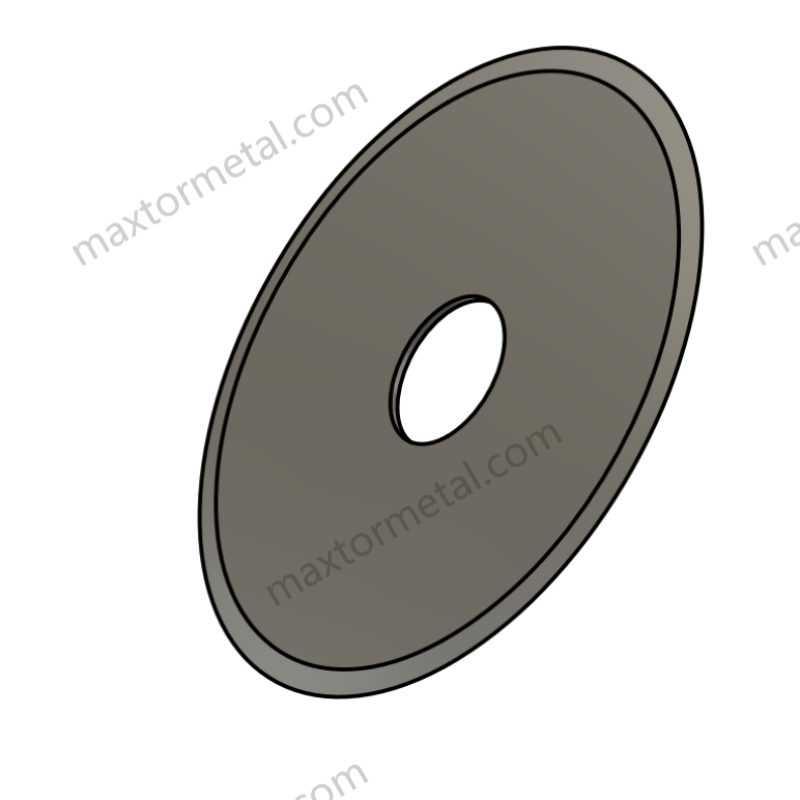
Si mantiene lubricadas las hojas de afeitar circulares y las piezas de la máquina, durarán más. La lubricación facilita el movimiento de las piezas y... detiene el óxidoAdemás, mantiene sus máquinas en buen estado. Puede evitar muchos problemas realizando un mantenimiento regular.
Lubricación de piezas móviles
Identificación de piezas que requieren lubricación
Debe saber qué piezas de la máquina necesitan aceite. Observe las juntas móviles y los soportes de las cuchillas. Revise las zonas de contacto entre metales. Estas zonas pueden resecarse o desgastarse. Si oye chirridos o ve puntos brillantes, esas piezas necesitan aceite.
Consejo: Consulta el manual de tu máquina para encontrar manchas de aceite. Marca estos puntos para recordarlos durante el mantenimiento.
Tipos recomendados de aceite para máquinas
Elija un buen aceite para máquina diseñado específicamente para su equipo. Algunos aceites contienen componentes que previenen la oxidación y el agua. Algunos aceites funcionan mejor si su máquina se calienta o trabaja mucho. Use siempre el aceite que se ajuste a las necesidades de su máquina.
| Tipo de aceite | Mejor para | Características principales |
|---|---|---|
| Aceite mineral | Uso industrial general | Buena lubricación, asequible. |
| Aceite sintético | Máquinas de alta velocidad o alta temperatura | Estable, resistente a las averías. |
| Aceites especiales | Ambientes húmedos o corrosivos | Protección adicional contra el óxido y el agua. |
Frecuencia de lubricación
Establezca un cronograma para engrasar sus cuchillas y piezas móviles. La mayoría de las máquinas necesitan... aceite cada 100 horas Algunas máquinas necesitan aceite con más frecuencia si trabajan en entornos difíciles. Consulte siempre la guía de su máquina para saber la sincronización correcta.
- Aceite cada 100 horas para la mayoría de las máquinas.
- Revise los niveles de aceite una vez a la semana.
- Agregue aceite después de limpiar o si las piezas se ven secas.
La lubricación suele impedir la entrada de agua, reduce la fricción y prolonga la vida útil de las máquinas. Las empresas que lubrican a tiempo tienen menos problemas y menos tiempo de inactividad.
Proceso de lubricación paso a paso
- Primero apague y desenchufe su máquina.
- Clean around each spot that needs oil.
- Put a little oil on each spot. Do not use too much.
- Move the parts by hand to spread the oil.
- Wipe off extra oil with a clean cloth.
- Check for leaks before you turn the machine back on.
Note: Too much oil can bring dust and cause trouble. Only use what you need.
Safety Precautions During Lubrication
Be safe when you use oil and work with machines.
- Wear gloves to keep oil off your skin.
- Use eye protection if oil might splash.
- Make sure the machine is off and cool before you start.
- Clean up any spills right away so no one slips.
- Keep oils in closed, labeled containers away from heat.
Prevención de la corrosión
Avoiding Prolonged Exposure to Alcohol or Harsh Chemicals
Do not leave your blades in alcohol or strong cleaners for a long time. These can take off the blade’s protective layer and cause rust. Use gentle cleaners and rinse blades well after washing.
Proper Drying Techniques After Cleaning
Dry your blades right after you clean them. Use a lint-free cloth to wipe off water. Compressed air can help dry hard-to-reach places. Never leave blades wet because even a little water can cause rust.
Applying Protective Coatings or Oils
After drying, put a thin layer of oil or coating on the blade. This keeps out air and water and stops rust. Special oils with anti-rust help protect blades for a long time.
Callout: Oiling your blades after cleaning can make them last twice as long and stay sharp.
Monitoring for Early Signs of Corrosion
Check your blades and machine parts often for rust or color changes. Look for orange spots, rough patches, or dull areas. If you see rust, clean and oil the part right away. Fixing it early stops it from getting worse.
- Check blades every week.
- Write down your maintenance checks.
- Replace any blade with deep rust or holes.
Oiling and taking care of your blades helps them last longer and cut better. When you do these steps, your machines work well and you save money on repairs.
Afilado de hojas de afeitar de doble filo

How to Sharpen a Double Edge Razor Blade
You can make a double edge razor blade sharp again. This helps the blade cut better and last longer. Many people in factories sharpen blades to keep them working well. There are a few ways to sharpen a double edge razor blade. The most popular way is with a leather strop. Stropping keeps the blade sharp by polishing it and taking off tiny rough spots. If your blade is very dull, you can use a sharpening stone or a diamond plate.
Here is how you sharpen with a strop:
- Put the strop flat on a table.
- Hold the blade at a 20-degree angle.
- Move the blade across the strop from the back to the front.
- Turn the blade over and do the other side.
- Do this 10 to 15 times for each side.
You need the right tools to sharpen double edge razor blades. Use a good strop, a fine abrasive, and wear safety gloves. Some people use a microscope to check the blade edge or put a special paste on the strop. These steps help you get a sharp and smooth blade.
Check your blade after every big job to see if it needs sharpening. Sharpen the blade if it feels harder to cut or does not work as well.
Scientists have found that sharpening changes the blade edge in tiny ways. A sharpened blade has a thinner edge and a better angle. This makes cutting easier. The table below shows how sharpening changes the force needed to cut:
| Parámetro | Sharpened Blade (Wear 0) | After Wear (e.g., Wear 12) |
|---|---|---|
| Median Cutting Force (g) | ~56.5 | ~67 |
| Mean Cutting Force Top (g) | ~54 | ~71 |
| Mean Cutting Force Bottom (g) | ~57 | ~63 |
| Adjusted Standard Deviation (g) | 5 | 8 |
| Number of Measurements | 20 | 20 |
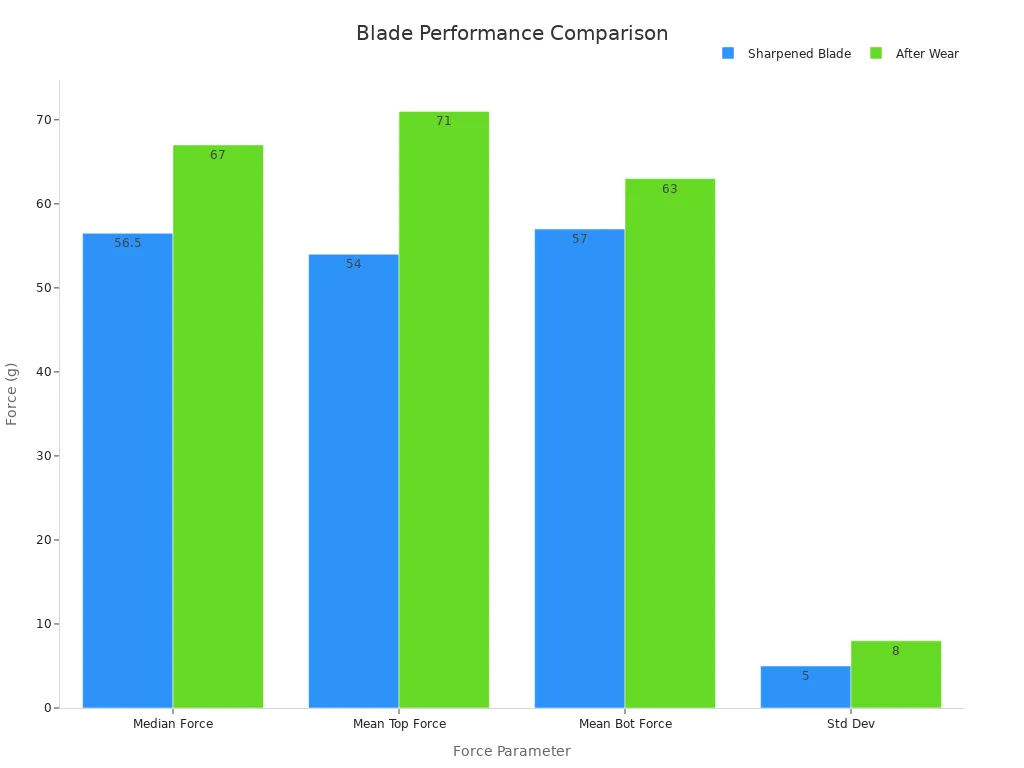
Why Sharpening a Double Edge Razor Blade Matters
It is important to know why sharpening a double edge razor blade matters. Sharpening often keeps your blades working their best. When you sharpen a double edge razor blade, you do not need as much force to cut. This means your machines do not wear out as fast. You also get smoother cuts. Sharpening helps you avoid stopping your work and saves money on new blades.
Sharp blades make a big difference in factories. They cut faster and cleaner. The data above shows that sharp blades need less force to cut. This helps them stay useful for a longer time. If you do not sharpen, blades get dull and are harder to use. This can slow down your work.
Sharpen your double edge razor blade before it gets too dull. This keeps your machines running well and your products looking good. Sharpening is an easy way to save money and use each blade longer.
If you want blades to last even more, work with a trusted double edge razor blades manufacturer. Nanjing Metal has 20 years of experience and offers custom help and sharpening support for factories. Their team knows the best ways to sharpen a double edge razor blade. They can help you pick the right tools and when to sharpen. Learn more about Nanjing Metal.
Tip: If you have questions about sharpening or want to order custom blades, talk to Nanjing Metal’s sales engineers for expert help.
Manejo y uso

Avoiding Damage
You can make your circular razor blades last much longer by handling them with care. Always pick up blades by the sides, not the sharp edge. When you move blades, use both hands and wear gloves to protect yourself and the blade. Never drop a blade or toss it onto a hard surface. Even a small fall can cause chips or cracks that ruin the blade’s edge.
Fortisblades designed their packaging with safety guards. These guards help you hold the blade the right way and keep the sharp edge safe. This kind of packaging shows that careful handling really does prevent damage. If you store blades in the wrong place or handle them roughly, you risk nicks, dings, or even breaking the blade. You should always use blade holders or cases when moving or storing blades. This keeps the edge sharp and ready for use.
When you clean blades, use soft brushes and gentle motions. Hard scrubbing or using metal tools can scratch the surface. Scratches make the blade dull faster and can lead to rust. After cleaning, dry the blade completely before putting it away. Moisture left on the blade can cause rust, which weakens the blade and makes sharpening less effective.
Consejo: Handle every blade as if it is brand new. Careful handling means fewer repairs and less time spent on sharpening.
Correct Application
You should always use circular razor blades for their intended industrial purpose. Each blade is made for a specific job, such as cutting film, paper, or plastic. Using a blade on the wrong material can cause it to dull quickly or even break. If you use the right blade for the right job, you will spend less time sharpening and more time working.
Never use a circular razor blade as a tool for prying, scraping, or cutting materials it was not designed for. This can bend the blade or damage the edge. When you notice the blade is not cutting as well, check if it needs cleaning or sharpening. Do not force a dull blade through tough material. This puts extra stress on the blade and the machine.
Set up a routine to check your blades before each shift. Look for signs of wear, chips, or bending. If you see any problems, fix them right away. Regular checks help you catch issues early, so you can sharpen or replace blades before they cause bigger problems.
| Common Mistakes | Resulting Damage | Prevention Tip |
|---|---|---|
| Using wrong material | Fast dulling, breakage | Haga coincidir la cuchilla con el material |
| Dropping blades | Chips, cracks | Use blade holders |
| Forcing dull blades | Bending, machine strain | Sharpen or replace as needed |
Nota: The right application and regular sharpening keep your blades working longer and your machines running smoothly.
Rotación y seguimiento de la cuchilla
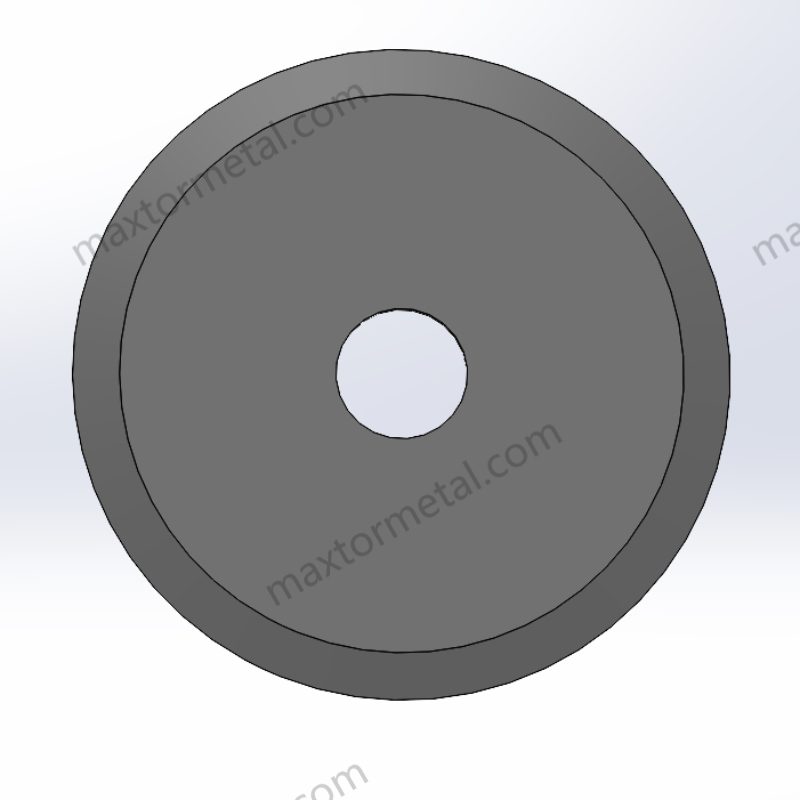
Rotating Blades
You can make your circular razor blades last longer by rotating them in your machines. When you use more than one blade at a time, each blade does not wear out at the same speed. Some blades cut more material or face more pressure. If you leave blades in the same spot, they wear unevenly. This can cause one blade to become dull or damaged before the others.
To solve this, you should rotate the blades on a regular schedule. Move each blade to a new position after a set number of hours or after each shift. This helps all blades wear at the same rate. You get more use from every blade, and you avoid sudden failures.
Consejo: Set a reminder to rotate your blades every week or after a certain number of production cycles. This simple habit can help you save money and keep your machines running smoothly.
Here is a sample rotation plan for a four-blade system:
| Week | Blade 1 | Blade 2 | Blade 3 | Blade 4 |
|---|---|---|---|---|
| 1 | A | B | C | D |
| 2 | B | C | D | A |
| 3 | C | D | A | B |
| 4 | D | A | B | C |
By following a rotation plan, you make sure no single blade gets overused. This keeps your cuts even and your production steady.
Usage Logs
Keeping a usage log helps you track how long each blade has been in service. You write down the date you install each blade, the position it starts in, and when you rotate or replace it. This record helps you spot patterns. You can see which blades wear out faster and adjust your rotation schedule.
A good usage log can look like this:
| Date | Blade Position | Hours Used | Maintenance Done | Notas |
|---|---|---|---|---|
| 2024-06-01 | 1 | 40 | Rotated | No issues |
| 2024-06-08 | 2 | 80 | Sharpened | Slight dullness |
| 2024-06-15 | 3 | 120 | Replaced | Edge chipped |
You can use a notebook, a spreadsheet, or special software. The important thing is to update your log every time you work with the blades. This habit helps you plan maintenance before problems happen. You avoid sudden breakdowns and keep your machines working longer.
Nota: Usage logs also help you order new blades on time. You know exactly when each blade needs attention.
If you want to learn more about soluciones de cuchillas personalizadas or need help setting up a tracking system, you can póngase en contacto con Nanjing Metal’s sales engineers for expert advice.
Hojas de afeitar circulares personalizadas
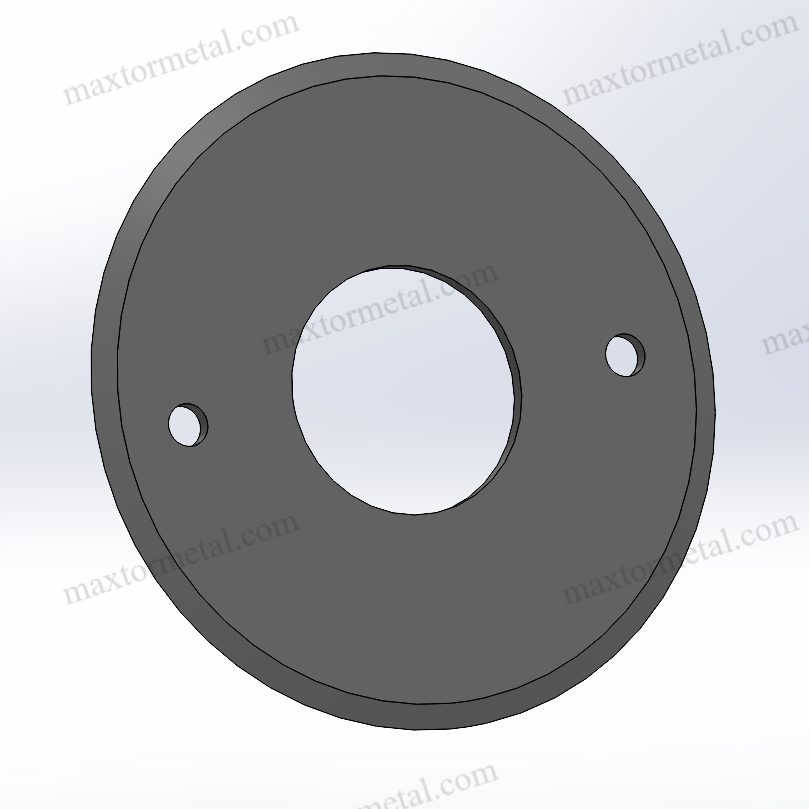
Beneficios de las cuchillas personalizadas
You can make your machines work better and save money by using custom circular razor blades. Custom blades let you pick the blade’s design, material, and coating for your needs. This helps you get better cuts and makes blades last longer.
Custom blades use special materials and coatings. You can choose from carbon steel, high-speed steel, tungsten carbide, ceramics, or stainless steel. Each material is best for certain jobs. Stainless steel does not rust, so it is good for food processing. Tungsten carbide is strong and works well with tough plastics and rubber. You can also pick the blade’s shape and edge. Some blades are solid discs, some have teeth, and others have special edges for slitting or making holes. These choices help you get fast, clean cuts every time.
Special coatings like TiN, CrN, or DLC make blades harder and smoother. These coatings lower friction and help blades last longer. Heat treating and cryogenic steps make blades even tougher. You will spend less time changing blades and more time using your machines.
Custom manufacturing lets you match the blade to your machine and product. You can ask for changes in size, thickness, or edge style. This means your blade will fit better and last longer in your setup. You also get better quality control. Each blade is tested to make sure it works for you.
Here is a table that shows how custom blades help different industries:
| Application Industry | Benefits of Custom Circular Razor Blades |
|---|---|
| Procesamiento de alimentos | Precise slicing and trimming with corrosion-resistant stainless steel blades. |
| Industria textil | Clean, efficient slitting with blades shaped for fabrics and nonwovens. |
| Rubber and Plastics | High wear resistance using tungsten carbide or alloy tool steel blades. |
| Metaltrabajando | Durable slitting and scoring with high-speed steel or carbide blades. |
| Medical & Pharmaceutical | Hygienic, corrosion-resistant cutting with stainless steel and ceramic blades. |
| Industria del Reciclaje | Long-lasting blades with special coatings for abrasive materials. |
Consejo: Custom blades help you cut faster, stop downtime, and make your products better.
Controles de inspección y mantenimiento

Regular inspection and maintenance help you keep your circular razor blades in top condition. You can spot problems early and fix them before they cause bigger issues. This section shows you how to check your blades and set up a good maintenance schedule.
Inspecciones regulares
Visual Inspection for Wear and Damage
You should look at your blades every day. Hold each blade up to the light. Check for chips, cracks, or uneven edges. If you see any damage, take the blade out of service. Damaged blades can break during use and hurt your machine or your product.
- Look for shiny spots or dark marks.
- Check both sides of the blade.
- Use a magnifying glass for a closer look.
Tip: A quick visual check can save you from costly repairs later.
Checking for Corrosion or Rust
Rust can make your blades weak. You need to check for orange or brown spots on the blade surface. If you find any, clean the blade right away. Use a soft cloth and a mild cleaner. Dry the blade completely before putting it back.
- Check the blade edge and the mounting holes.
- Look for rough patches or pitting.
- Clean and oil the blade if you see any signs of rust.
Assessing Blade Sharpness
Sharpness is key for good cutting. You should test the blade’s edge before each shift. Run a piece of test material through the machine. If the blade does not cut cleanly, it may need sharpening. You can also touch the edge gently with a wooden stick. A sharp blade will shave off a thin layer.
- Test with the same material you use in production.
- Compare the cut to a new blade’s cut.
- Record the results in your maintenance log.
Note: Keeping track of sharpness helps you plan sharpening before the blade gets too dull.
Inspecting Blade Alignment and Mounting
Blades must sit straight and tight in the machine. Check the mounting bolts and alignment marks. If the blade wobbles or sits at an angle, adjust it right away. Misaligned blades wear out faster and can damage your machine.
- Spin the blade by hand to check for wobble.
- Tighten loose bolts.
- Use alignment tools if your machine has them.
Maintenance Schedules
Establishing Inspection Intervals
You need a clear schedule for inspections. Daily checks catch small problems. Weekly and monthly checks go deeper. Write down your plan and share it with your team.
| Tarea | Interval |
|---|---|
| Visual inspection | A diario |
| Rust and corrosion check | Semanalmente |
| Sharpness test | Semanalmente |
| Alignment and mounting | Semanalmente |
| Full cleaning and oiling | Mensual |
Callout: A set schedule keeps everyone on track and your blades in top shape.
Daily, Weekly, and Monthly Maintenance Tasks
You should break down your maintenance into daily, weekly, and monthly tasks. This makes it easy to remember what to do and when.
- A diario:
- Wipe down blades after use.
- Check for chips or cracks.
- Remove dust and debris.
- Semanalmente:
- Inspect for rust or corrosion.
- Test blade sharpness.
- Check alignment and mounting.
- Record findings in your log.
- Mensual:
- Deep clean all blades.
- Apply protective oil.
- Perform full sharpening if needed.
- Review maintenance records.
Documentation and Tracking
Keeping good records helps you spot patterns. Use a logbook or a digital spreadsheet. Write down each inspection, sharpening, and replacement. This helps you know when to sharpen or replace a blade.
| Date | Blade ID | Tipo de inspección | Sharpness Level | Sharpening Done | Notas |
|---|---|---|---|---|---|
| 2024-06-01 | B-101 | Semanalmente | Bien | No | No issues |
| 2024-06-08 | B-101 | Semanalmente | Justo | Sí | Sharpened edge |
| 2024-06-15 | B-101 | Semanalmente | Bien | No | After sharpening |
Note: Good documentation helps you plan sharpening and replacement. You avoid surprises and keep your machines running.
Cuándo reemplazar las hojas de afeitar circulares

You need to know when to change your circular razor blades. This helps your machines stay safe and work well. If you wait too long, your equipment can get damaged. Your work may slow down, and your products might not look good. Watch for these signs that show your blade needs help.
Señales de reemplazo
Dullness or Reduced Sharpness
Your blade may not cut as well as before. You might need to push harder to cut things. If you see rough edges on your materials, your blade is not sharp anymore. This means you should sharpen or replace your razor blade.
Visible Damage (Nicks, Chips, or Cracks)
Look at your blade for small nicks, chips, or cracks. Even tiny marks can make the blade weak. A weak blade can break while you use it. Broken blades can scratch or tear your materials.
Presence of Rust or Corrosion
Check for orange or brown spots on the blade. Rust and corrosion make the blade weak and unsafe. If you see rust, change the blade right away.
Poor Cutting Performance (Increased Resistance or Inconsistent Cuts)
If your blade has trouble cutting or leaves uneven edges, it may be time for a new one. Bad cuts often mean the blade is dull, broken, or not lined up right. You may also notice your machine working harder.
Ruidos inusuales durante el funcionamiento
Listen for odd sounds when your machine is running. Squeaks, grinding, or rattles can mean the blade is broken or not in place. These sounds warn you before bigger problems happen.
Deformación o alabeo de la hoja
If a blade looks bent or twisted, it will not cut straight. Warped blades can jam and hurt your machine. Always change any blade that does not keep its shape.
Frequent Material Jamming or Snagging
If your machine jams or snags a lot, the blade may be the reason. Dull or broken blades catch on materials and slow you down. Lots of jams mean you should check and maybe change the blade.
Consejo: Check your blades often for these signs. Changing blades early stops big problems and keeps your work moving.
Riesgos de un reemplazo tardío

Waiting too long to change your circular razor blades can cause big trouble. Here are some main risks:
Increased Risk of Machine Damage
Old blades can get very hot, sometimes up to 475 °C. This heat can hurt both the blade and your machine. Machines with dull blades break more and need more repairs.
Higher Likelihood of Product Defects
Dull or broken blades make rough, messy cuts. You may see more bad parts or wasted materials. Bad cuts can mean your products do not pass quality checks.
Reduced Production Efficiency
If blades do not work well, machines slow down. You may have to stop work to fix jams or change parts. Slow machines can make you miss deadlines and lose money.
Peligros de seguridad para los operadores
Blades with chips, cracks, or rust can break while you use them. Broken blades can hurt people working with the machines. Good blades help keep everyone safe.
Escalating Maintenance Costs
If you wait too long to change blades, repairs cost more. Machines may need new parts or longer fixes. You also spend more on work and new materials.
Potential for Unplanned Downtime
Broken or hot blades can make machines stop without warning. This means lost work time and late orders. Delays can hurt your business and your good name.
- Old blades often get too hot and damage machines.
- Dull blades need more force, which can break machines and slow work.
- Broken blades cause surprise stops and higher repair bills.
- Regular care and changing blades on time keep your work going well.
Nota: Watch your blades and change them when needed. This saves money, keeps people safe, and helps your machines work their best.
You can help your circular razor blades last longer if you do a few easy things:
- Wipe off blades every time you use them.
- Keep blades in a dry spot so they do not rust.
- Put oil on moving parts often to stop them from sticking.
- Make blades sharp again before they get too dull.
- Get a new blade if you see any chips or cracks.
Taking care of your blades helps your machines work well and saves you money.
Preguntas frecuentes
How often should you clean industrial circular razor blades?
Clean your blades after every shift or job. This removes dirt and stops rust. Cleaning often keeps blades sharp and machines working well.
What is the best way to store circular razor blades?
Keep blades in a dry place with good airflow. Use blade holders or cases so they do not get damaged. Make sure the room stays under 50% humidity. Good storage stops rust and keeps blades ready.
¿Cómo saber cuándo es necesario reemplazar una cuchilla?
Check for dull edges, chips, rust, or bad cuts. If you see any of these, change the blade right away. Replacing blades quickly keeps machines safe and cuts clean.
Can you sharpen all types of circular razor blades?
Most industrial blades can be sharpened, especially if made from strong steel. Some blades with special coatings or materials may need a pro to sharpen or replace them. Always check what your blade needs.
What are the main causes of blade wear?
Blades wear out from cutting rough stuff, not cleaning, bad storage, or using the wrong blade. Taking care of blades and using them right helps them last longer.
Why choose a custom blade manufacturer for your needs?
A custom blade maker makes blades just for your job. You get a better fit, longer use, and better results. For expert help, you can trust Nanjing Metal, a top blade maker with 20 years of experience.
Ver también
Production Process of Circular Blade Cutting
Best Material Choices for Circular Slitting Blades: Key to Efficiency and Durability
How to effectively extend the service life of tungsten steel circular blades?


